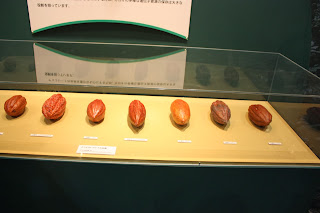Cost: 1300 yen for adults, 800 for students (cost of seeing the rest of the science museum is included)
Good for: Single people, couples, small groups
The Chocolate Exhibition was a temporary exhibit at the Nagoya City Science Museum that I managed to visit. I got a warning from one of the staff that let me into the exhibit that I could only walk in once: once I left the exhibit itself, I was out. The exhibit held a lot of different things for people to look at, and I enjoyed the many visual displays that ranged from actual, old items to pictures and text passages explaining what everything was (in Japanese). The history of chocolate was written in the passages, but even if you can't read Japanese, the exhibit an enjoyable trip. There were a few things that were designed to entertain children, but they came near the end of the exhibition.
While I enjoyed the exhibit, there was only one path. Because it was a bit crowded when I got there, I ended up feeling a bit pressured by the people behind me and slowed down by the people in front of me. This made it harder to get pictures, but I still got ones of the more interesting things. The fact that chocolate was mainly used as a drink, and the different cultures drinking it had special cups for them, was surprising. I almost always think of chocolate as a food first and a drink second. Some of the cups were very beautifully designed and reminded me of seto ware.
The exhibit didn't just have old cups and tools, though. There were also sculptures made of chocolate! Each of the animals in the sculpture above was made using a different type of chocolate. The vibrant and realistic coloration surprised me. There were other sculptures on displayed as well, and all of them were truly works of art with different styles. The different colors were probably made using different cacao beans. Cacao beans have an impressive range of colors, sizes, and textures. Some of them could fit easily in my palm while others were bigger than my hand.
The entire experience of the exhibit was one of the funnest I've had. Despite the fairly large number of people, I got to see everything in the exhibit as well as take pictures of the fascinating stuff. The end of the exhibit actually had a souvenir shop of sorts where they sold a large variety actual chocolate as well as a number of chocolate-based key-chains, pencils, and other paraphernalia. I would definitely recommend seeing this to anyone that has the opportunity. It's mostly suited for couples or people who are alone, and it is too small to fit a group of more than four and still have it be a group experience.





